The world’s leading ‘secondary’ large city airports – are there similarities & synergies? Part one
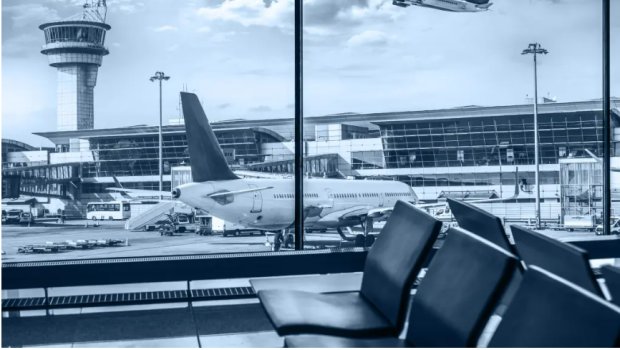
It is the world's primary hub airports which catch the attention and the imagination. They are the ones that are recognised as the 'gateway' to and from a country, as if others did not exist. Primary hub airports tend to be regarded as glamorous, and have TV programmes made about them. But in the background are many examples of 'second' city airports, some of which carry very significant amounts of freight and passengers, but which go unrecognised. This three-part report lists the Top 10 as far as can be ascertained by passenger numbers in 2023, with a short portrait of each one. The report also briefly touches on the similarities between them, and asks if any synergies can be identified and used, by way of research, to improve the passenger experience. Part one features the introduction and a look at Newark Liberty, Shanghai Hongqiao and London Gatwick airports; part two will look at Istanbul Sabiha Gökçen, Tokyo Narita, Beijing Daxing and Paris Orly airports; and part three will look at Bangkok Don Mueang, Seoul Gimpo and São Paulo Congonhas airports, as well as sharing some concluding views.
Summary
- The world's 'second' city airports count among the most used by passengers, with up to 50mppa, but in the wider scheme of things they still lag behind the principal hub airports.
- Leading the pack are New York, London, Paris, London, and the Chinese airports at Shanghai and Beijing.
- Their number will be augmented within a few years by new ones in India, the Philippines and Australia, among other countries.
- There are discernible similarities between them, positive and negative, especially where budget travel is concerned, both short and long haul.
- Consequently, there are opportunities for synergies to be found and enhanced, even for direct co-operation between them.
- That would be simpler where they are independently owned and operated, separate from the principal airport - and quite a few are.
Istanbul's Sabiha Gökçen airport is a shining example of the role a 'secondary' airport can play in handling air transport in a large city
The recent CAPA - Centre for Aviation report on Istanbul's record breaking 'second' city airport, Sabiha Gökçen, revealed its underlying pattern of growth, strength, staying power and ambition in a two-airport city administration, under which each of the airports is under separate ownership and control.
The conclusion that was reached was that Sabiha Gökçen is much more than merely a secondary facility, and is "on track to become one of the world's leading examples of how a secondary-level airport for a city should function".
And that prompts the question of how important such secondary airports serving big cities are in the overall scheme of things. More often than not, they are the 'bridesmaids' - the ones that don't have fly-on-the-wall TV documentary series made about them, and which are only mentioned in the media at all when things go wrong.
The objective of this report is to look at a grouping of the top 'second airports' worldwide and to analyse the role they play within their own domain.
Are there any commonalities, or synergies? Would any degree of co-operation between them be beneficial? The table below is a subjective appraisal of these leading airports, the top 10 in the world as measured by passenger traffic in 2023.
The busiest is listed first. In some cases full year 2023 statistics have not yet been made available, and that fact is indicated as appropriate.
To give some idea of the degree of influence of these airports: New York Newark Liberty Airport was the world's 23rd busiest airport in its own right in 2022, and the 13th busiest in the US. London Gatwick was the second busiest in the UK, a status it appears to hold perennially, and 35th in the world.
Shanghai Hongqiao barely figured at all, though, in 2022, owing to the very slow recovery from the COVID-19 pandemic in China, and did not even figure in the top 50 in the world in that year. Its place in this 2023 table is down to a spectacular recovery at both the Shanghai airports in that period.
It should be noted though that the highest ranking for passenger seat capacity at any of these airports in week commencing 04-Mar-2014 is Beijing Daxing (34th), which is testimony to the staying power of the primary hub airports.
Primary airports (top 10): ranked, passengers FY2023, performance against previous year, global position
|
Rank |
Airport/Country |
Passengers: FY2023 unless indicated otherwise in Notes |
+/- previous year |
Notes |
Rank by global position: passenger seat capacity in the week commencing 04-Mar-2024 |
|
1 |
49,100.000 |
+13% |
41 |
||
|
2 |
42,500,000 |
+300% |
37 |
||
|
3 |
37,800,000 |
+25% |
Jan-2023 to Nov-2023 only |
63 |
|
|
4 |
37,050,000 |
+20.5% |
62 |
||
|
5 |
32,700,000 |
+112% |
57 |
||
|
6 |
32, 376,000 |
+238% |
Jan to Nov-2023 only |
34 |
|
|
7 |
32,295,000 |
+10.6% |
75 |
||
|
8 |
26,980,000 |
67.3% |
77 |
||
|
9 |
23,425,000 |
(-4.5%) |
139 |
||
|
10 |
22,030,000 |
+21.9% |
99 |
Source: CAPA - Centre for Aviation Airport Profiles.
There now follows a brief examination of each of these airports and their local position and importance.
Further information can be found in CAPA - Centre for Aviation Airport Profiles, and the CAPA - Centre for Aviation Construction and Investor databases.
Newark Liberty Airport (EWR) - New York's second airport, across the Hudson
Newark Liberty International Airport, as far as can be ascertained the leading 'second' city airport as measured by passenger numbers, is presently (week commencing 04-Mar-2024) the 41st airport in the world for seat capacity, the 27th for frequencies and the 45th for cargo payload (out of 3,893 airports globally in this and all other examples in this report).
It is located in Newark, New Jersey, 24km from New York City's Manhattan borough and equidistant from Lower Manhattan, as are the J F Kennedy and LaGuardia airports. Newark serves New York City and the wider Tri-State metropolitan region, and is a major international gateway to the United States as a whole.
The airport can be accessed in approximately an hour from midtown Manhattan by public transport or tunnels beneath the Hudson River, which is why it can reasonably be referred to as a New York airport.
The airport is operated, in common with the others, by the Port Authority of New York and New Jersey - although it is owned by the City of Newark.
Passenger traffic since 2009 has grown from 33.4 million to the 2023 figure (which exceeded that of 2019) of 49.1 million, which is approximately 15 million short of that of the JFK airport there, and approximately 17 million more than at the LaGuardia facility.
New York Newark Liberty International Airport: annual traffic, passenger numbers/growth, 2009-2024
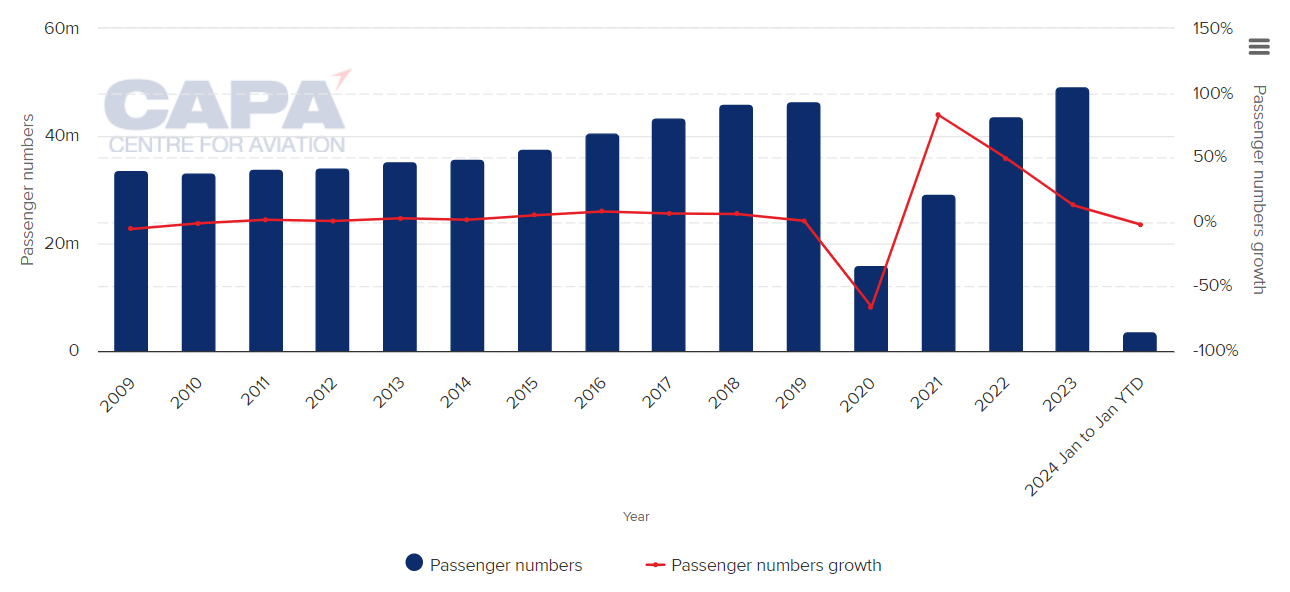
Source: CAPA - Centre for Aviation and The Port Authority of New York and New Jersey.
By operated capacity, United is the largest airline at the three-terminal airport, with 68% of seat capacity and 71% of movements.
Less than 12% of seats are on low cost carriers, and the Star Alliance (mainly through United) has 75% of capacity.
EWR, its IATA code, has a comprehensive route map, with extensive domestic and Caribbean connections, as well as spanning the main continents.
New York Newark Liberty International Airport: network map for the week commencing 04-Mar-2024
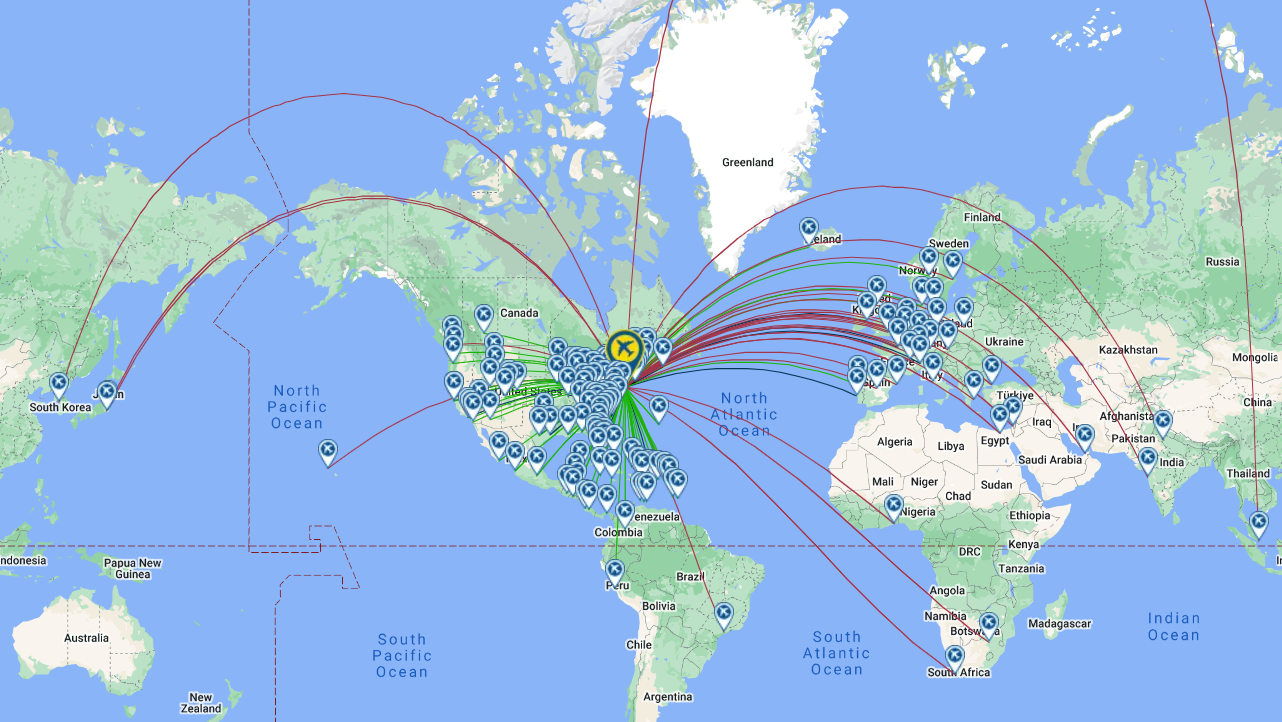
Source: CAPA - Centre for Aviation and OAG.
Various projects are under way or recently completed to the value of USD3.3 billion at EWR, including a new terminal (A), terminal renovation, new taxiways, runway rehabilitation and a new apron (according to the CAPA Airport Construction Database).
The Port Authority's USD9.3 billion budget for 2024 includes development of a new AirTrain Newark system to replace the existing one and bring surface transport there up to speed.
Shanghai Hongqiao International Airport (SHA) - making a strong post-pandemic recovery
Shanghai Hongqiao International Airport is the 37th largest in the world as measured by seat capacity, the 54th for frequencies, and the 27th for cargo payload.
It is the smaller and more centrally located airport serving Shanghai, and is operated by the Shanghai Airport Authority. The airport was the principal one serving Shanghai until the construction of an international airport at Pudong.
Although the airport carries the tag 'international', services at Hongqiao are almost exclusively domestic and short haul international (6.5% of seat capacity), with longer-haul services having been transferred to Pudong.
Passenger traffic grew consistently in each year from 2009 to 2019 (and even including 2019, despite COVID).
That growth is clear in the table, and that the recovery from the COVID-19 pandemic was very strong in 2023. Moreover, it continued in 2024, with 48% growth in January.
Shanghai Hongqiao International Airport: annual traffic, passenger numbers/growth from 2009 to 2022
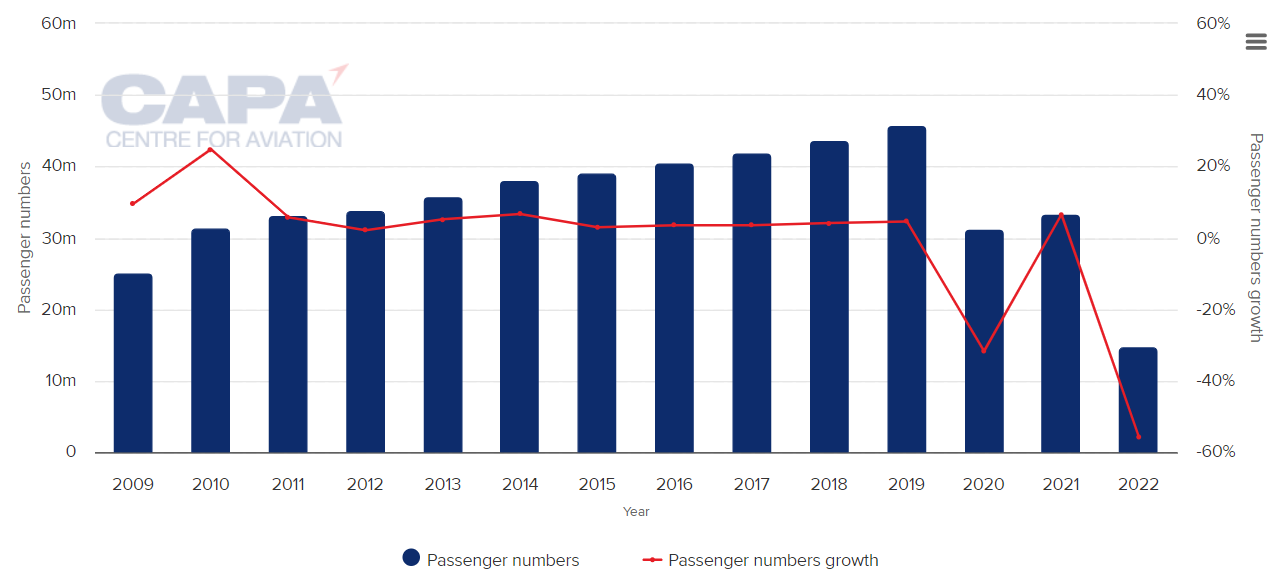
Source: CAPA - Centre for Aviation and CAAC.
There is a broad mix of airlines, with the largest being China Eastern Airlines on 34.5% of capacity.
It is a full service airport, with 90% of capacity in that segment. Five alliances operate there, accounting for 62.4% of capacity.
The route network is centred on eastern China, with only a single route to the west (Urumqi) and five international routes, out of 60 in total.
Shanghai Hongqiao International Airport: network map for the week commencing 04-Mar-2023
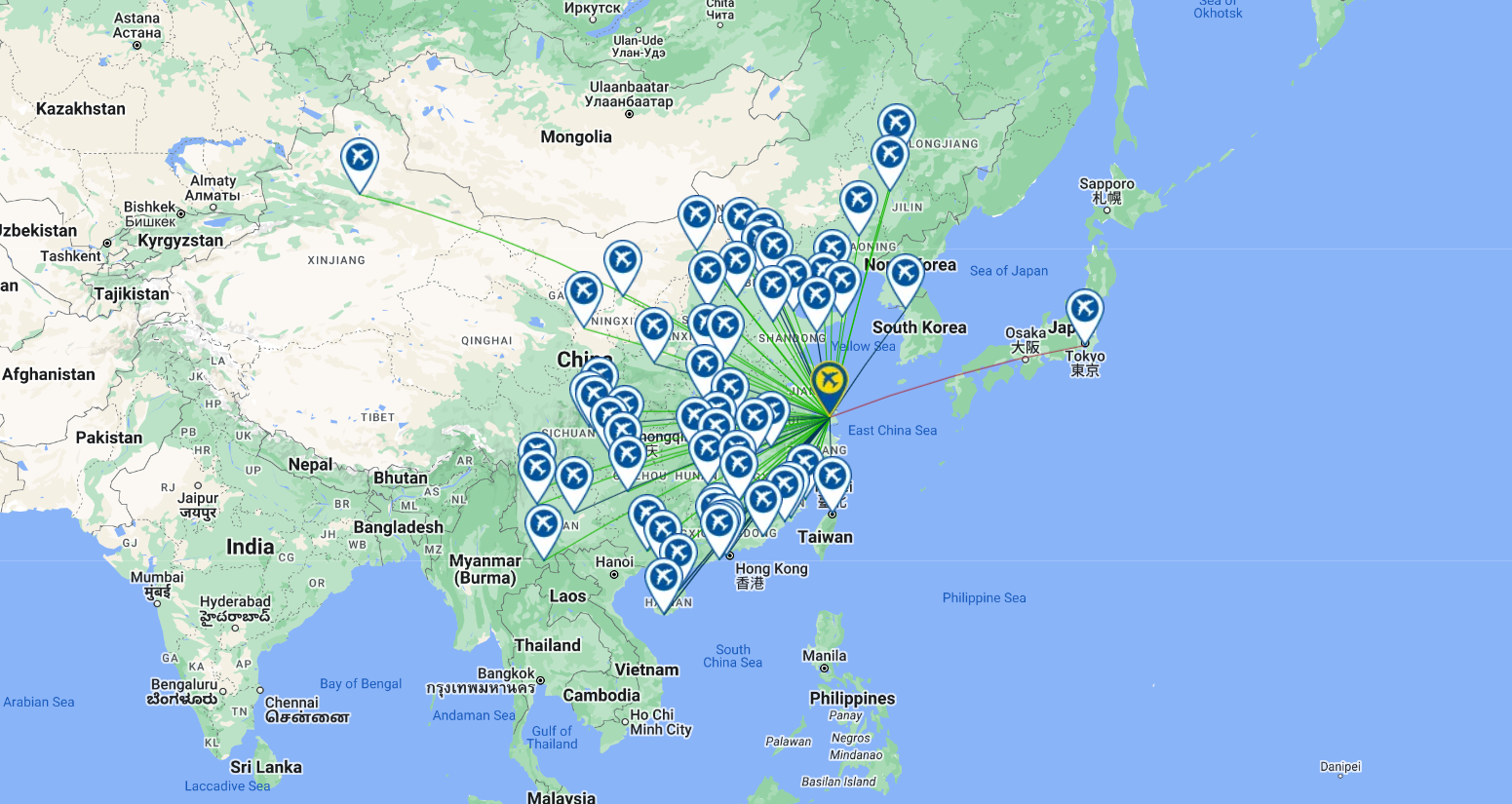
Source: CAPA - Centre for Aviation and OAG.
Between 2014 and 2018 the airport experienced a very large-scale renovation.
There are no known construction projects presently.
London Gatwick Airport (LGW) - 'I get knocked down, but I get up again'
London Gatwick, to the south of the UK capital, lying between it and the seaside city of Brighton, is ranked 63rd in the world for seat capacity, 73rd for flight frequencies and 149th for cargo payload.
Gatwick is one of six airports serving London, an aviation system in its own right and the world's largest one by far and the airport is considered to be the second most important of them. Its business model mix is the most diverse, compared to Heathrow (predominantly full service) and Stansted (almost exclusively low cost) airports.
Once a BAA plc airport, London Gatwick Airport is now operated by Gatwick Airport Ltd., a wholly owned subsidiary of Ivy Holdco, of which the biggest shareholder is VINCI Airports. Other equity holders do so under the umbrella of Global Infrastructure Partners, which has been responsible for its development since 2009.
It mainly serves the heavily populated 'Home Counties' (Surrey, East and West Sussex, and Kent) to the south of London, although improved rail services now ensure that it can be easily accessed from north of the capital.
Gatwick was one of the worst-affected airports in the UK by the COVID-19 pandemic, handling only six million passengers in 2021, but has recovered strongly. Even so, it has lost critical services from Virgin Atlantic and to a lesser degree from British Airways and Norwegian, partly countered by gains from Norse Atlantic and JetBlue.
EasyJet is now by far the largest airline, with 43% of capacity and 54% of movements. Gatwick is a low cost carrier-oriented facility (67.4%), compared to only 2% being operated by LCCs at London Heathrow. Representation by airline alliances is low, at only 21% of capacity.
Passenger growth was generally positive in the decade from 2009 to 2019, and the airport enjoyed its best-ever passenger total in the pre-pandemic year.
London Gatwick Airport: annual traffic, passenger numbers/growth, 2009-2023 (Jan-Nov)

Source: CAPA - Centre for Aviation, London Gatwick Airport and UK CAA
The route network is a comprehensive one, with a particular focus outside Europe on the east coast of North America and the Caribbean.
On the other hand, the only main continent not served is South America.
London Gatwick Airport: network map for the week commencing 04-Mar-2024
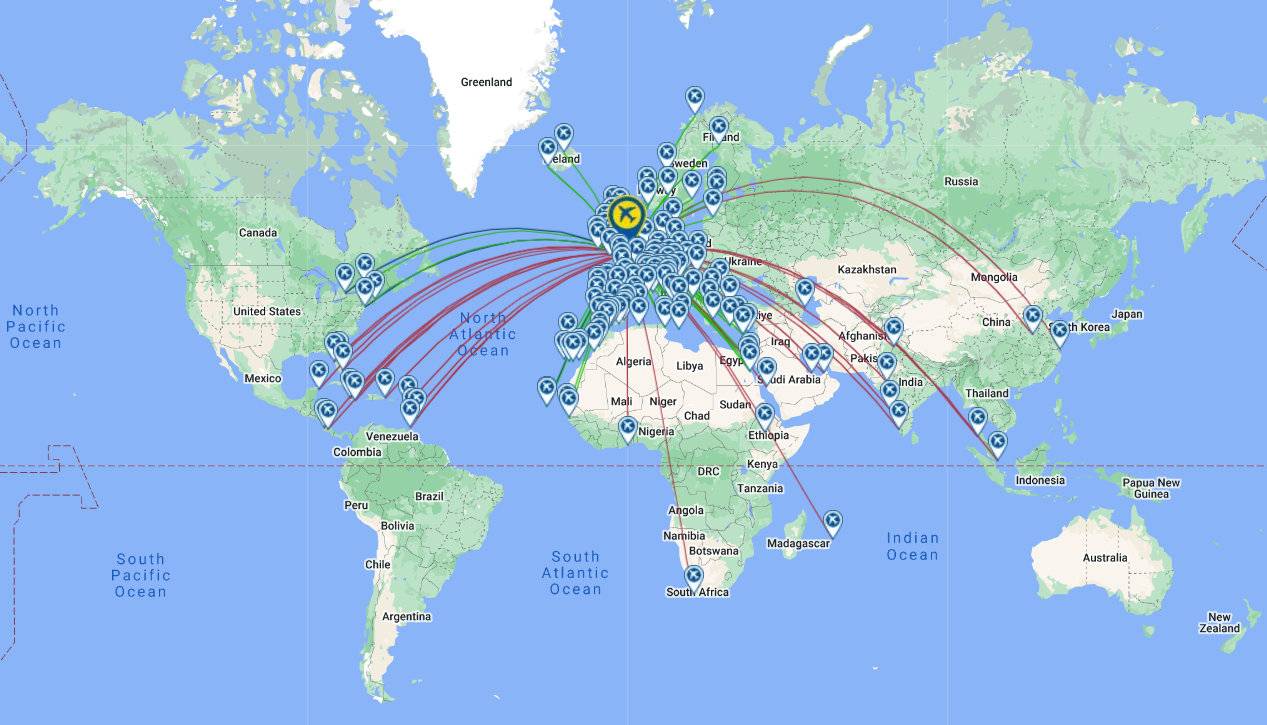
Source: CAPA - Centre for Aviation and OAG.
Gatwick has two terminals and is (arguably) the busiest single runway airport in the world.
The main focus on expansion now is on bringing back into service as a runway what now serves as a taxiway, for short/mid haul take-offs only. That application process continues. Even then, it would be well into the next decade before it opened, along with terminal expansion.
Gatwick failed to convince the Airports Commission that it should be the site of a further full runway for the Southeast of England in 2015, which may have influenced ownership changes since then.
Part two of this report will look at Istanbul Sabiha Gökçen, Tokyo Narita, Beijing Daxing and Paris Orly airports,
Part three will look at Bangkok Don Mueang, Seoul Gimpo and São Paulo Congonhas airports, as well as sharing some concluding views.


